Not all connectors are the same and so choosing the right one for the job in hand can be a daunting task. Different shapes, materials and locking mechanisms form a bewildering array of choice. Add in the potential for captive eyes, swivels or pulley variations and the list of options is vast. To help simplify this selection process, we have compiled a prompt sheet that will help you decide what you want from a carabiner style connector.
1: Should I choose Alloy or Steel?
Choosing the correct metal for the connector is a fundamental part of the selection process:
Alloy connectors are lighter and exceptionally strong for their weight. They can be hot forged into intricate designs that allow them to be optimally shaped for strength whilst retaining their lightweight characteristics. Alloy connectors tend to be rated up between 23 – 30kN.
Carbon Steel connectors are heavier than alloys but are much stronger and have exceptionally high wear resistance. Stainless steel connectors don’t reach quite the same strengths as Carbon Steel, but have incredible resistance to corrosion in hostile environments and are especially suited for work in and around marine environments. Carbon steel connectors are usually rated between 35 - 50kN and Stainless Steel connectors between 25 and 32kN.
2: Which shape and size of connector do I need?
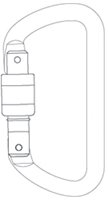 D shape connector bodies are designed to force the loads closer to the spine of the connector (the strongest orientation), therefore maximising strength. These are probably the most basic of all connectors in terms of shape, but this makes them a perfect choice in applications where strength and simplicity are paramount. They vary in length between the compact Steel Oval at 105mm to the mighty Ultra D at 117mm.
D shape connector bodies are designed to force the loads closer to the spine of the connector (the strongest orientation), therefore maximising strength. These are probably the most basic of all connectors in terms of shape, but this makes them a perfect choice in applications where strength and simplicity are paramount. They vary in length between the compact Steel Oval at 105mm to the mighty Ultra D at 117mm.
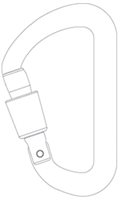 The Offset D connector shape takes the optimal loading of a D shaped connector ie. load along the spine, and extends the basket outwards to increase gate opening and clipping volume. This adds to the positivity in the hand, especially when wearing gloves. Again, DMM Offset Ds vary dramatically in size from the featherweight Phantom at 94mm upwards.
The Offset D connector shape takes the optimal loading of a D shaped connector ie. load along the spine, and extends the basket outwards to increase gate opening and clipping volume. This adds to the positivity in the hand, especially when wearing gloves. Again, DMM Offset Ds vary dramatically in size from the featherweight Phantom at 94mm upwards.
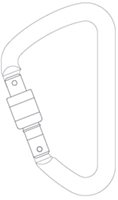 Klettersteig connectors look and behave very similarly to Offset Ds, but are wider. This design helps maximise gate opening and internal working volume, whilst still allowing any loads to be located as close to the spine of the connector as possible. Klettersteig connectors must pass an additional test to any of the other connectors as they are often subjected to loads in sub-optimal orientations.
Klettersteig connectors look and behave very similarly to Offset Ds, but are wider. This design helps maximise gate opening and internal working volume, whilst still allowing any loads to be located as close to the spine of the connector as possible. Klettersteig connectors must pass an additional test to any of the other connectors as they are often subjected to loads in sub-optimal orientations.
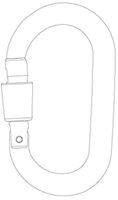 Oval connectors are popular in rope access and treecare situations where multiple connectors, slings, ropes or even pulleys may be connected into one. That said, they are equally at home in fall arrest situations or as part of a pre-rigged rescue system. The round basket shape allows any of the connection points to self-centre when weighted – this helps avoid the un-nerving click that often happens with a more D shaped connector. The symmetrical baskets mean rotation within systems is not required as they sit comfortably either way round.
Oval connectors are popular in rope access and treecare situations where multiple connectors, slings, ropes or even pulleys may be connected into one. That said, they are equally at home in fall arrest situations or as part of a pre-rigged rescue system. The round basket shape allows any of the connection points to self-centre when weighted – this helps avoid the un-nerving click that often happens with a more D shaped connector. The symmetrical baskets mean rotation within systems is not required as they sit comfortably either way round.
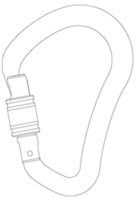 Pear shape connectors (usually referred to as HMS connectors) often have similar characteristics to ovals in how they deal with loaded components ie. They also allow devices and connectors to self-centre. Moreover, the extended basket allows for additional component connection. Knots in a system such as an Italian hitch can rotate easily between taking-in and giving out (even with larger diameter ropes). In general, pear shaped connectors are slightly oversized to accommodate the added volume of bigger ropes and to feel secure in a gloved hand.
Pear shape connectors (usually referred to as HMS connectors) often have similar characteristics to ovals in how they deal with loaded components ie. They also allow devices and connectors to self-centre. Moreover, the extended basket allows for additional component connection. Knots in a system such as an Italian hitch can rotate easily between taking-in and giving out (even with larger diameter ropes). In general, pear shaped connectors are slightly oversized to accommodate the added volume of bigger ropes and to feel secure in a gloved hand.
DMM connectors also come with specialist shapes and features that differentiate them from our standard range:
The DMM Revolver incorporates a pulley wheel in its rope running basket to alleviate friction and drag. This gives mechanical advantages in lightweight, compact systems that help keep things as efficient as possible without equipment overload.
The DMM Sidewinder incorporates a swivel eye to help combat torsion and twisting in a system and to allow easy rotational manipulation of loads. Think of it as a swivel/connector combination and you’ll get the idea of its versatility.
3: Is the connector to be captive or not?
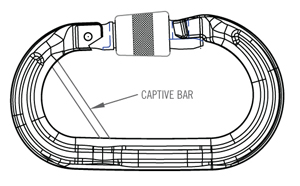 Sometimes it is essential for a connector to stay in the correct orientation or to be permanently attached to a system. Both our Sidewinder connector and our Captive Eye connector with their textile friendly attachment holes can be stitched into a rope or webbing loop, or swaged directly onto cable.
Sometimes it is essential for a connector to stay in the correct orientation or to be permanently attached to a system. Both our Sidewinder connector and our Captive Eye connector with their textile friendly attachment holes can be stitched into a rope or webbing loop, or swaged directly onto cable.
If, however, stitching a connector into a system isn’t an option, many of our connectors have a captive bar option allowing them to be clipped into a system as a normal connector but with an option of adding a small pin to secure their orientation. Not only does this make them more resistant to cross loading, but it also makes them more difficult to tamper with or remove.
4: Which locking mechanism will best suit my needs?
All PPE connectors require at least 1 additional locking/unlocking operation before the gates can be opened ie. a simple snap link connector with a sprung gate or wire gate will not pass the EN362 connector standard and so can only be used for accessories and non-PPE applications. Our locking mechanisms give varying degrees of protection versus ease of use and easy opening.
Screwgate connectors do not auto lock and therefore require the user to activate the locking function. Whilst this has some disadvantages in terms of instant security offered by our other gates, it allows the user to clip ropes, sling and devices with one hand and then close the lock afterwards (clipping anything into an auto-locking connector with one hand is problematic at best). This is why they are the most popular choice for Rope Access Technicians.